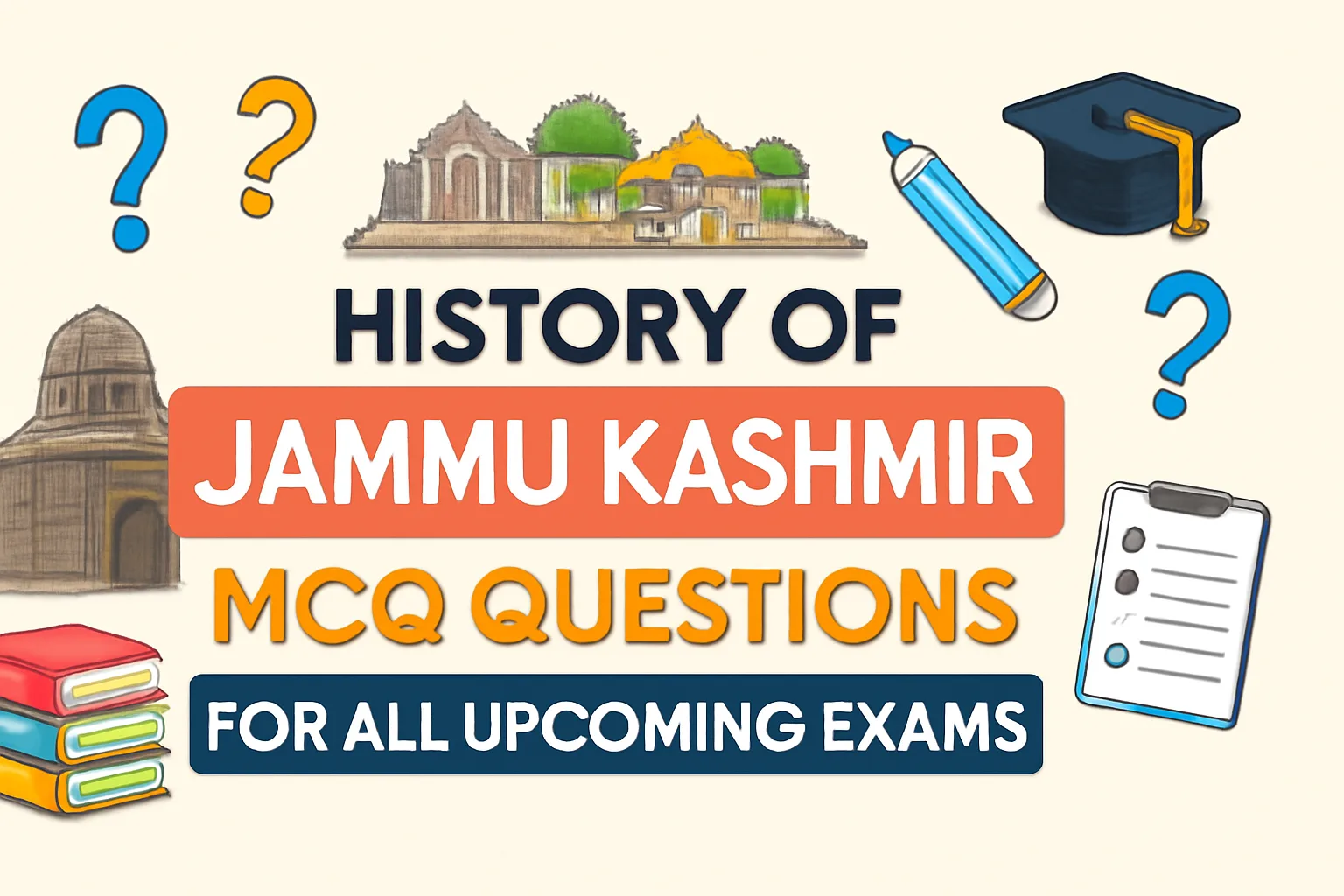The history subject plays an important role in all competitive exams held by the JKSSB in Jammu and Kashmir. The history subject is the major portion of any exam, with around 5 to 6 questions asked from the history portion. After you complete your history syllabus from the concerned sources, you can solve the following MCQs on the history portion, which will help you revise and track your preparation level for upcoming exams.
These MCQs have a special focus on the History of J&K.
1. The Former State of Jammu and Kashmir came into existence by which treaty signed on March 16, 1846?
A) Treaty of Lahore
B) Treaty of Amritsar
C) Treaty of Kashmir
D) Treaty of Jammu
Answer: B) Treaty of Amritsar
2. Which of the following rulers was the founder of the State of Jammu and Kashmir, formed in 1846?
A) Maharaja Hari Singh
B) Maharaja Ranbir Singh
C) Maharaja Gulab Singh
D) Raja Amar Singh
Answer: C) Maharaja Gulab Singh
3. The erstwhile State of Jammu and Kashmir consisted of which three main regions in 1846?
A) Jammu, Kashmir, Ladakh
B) Jammu, Gilgit, Baltistan
C) Kashmir, Leh, Kargil
D) Jammu, Poonch, Baramulla
Answer: A) Jammu, Kashmir, Ladakh
4. Which country illegally occupied 37,555 sq. km of Aksai Chin from the erstwhile State?
A) Pakistan
B) China
C) Afghanistan
D) Nepal
Answer: B) China
5. Pakistan handed over 5,180 sq. km of the Shaksgam Valley to China in which year?
A) 1954
B) 1963
C) 1971
D) 1948
Answer: B) 1963
6. The international boundary of the erstwhile Jammu and Kashmir with China is approximately how many kilometers?
A) 365 km
B) 221 km
C) 465 km
D) 1001 km
Answer: C) 465 km
7. Which of the peaks mentioned below is the second-highest peak in the world, located in the Union Terriotry of JK
A) Nanda Devi
B) K2
C) Mount Everest
D) Kanchenjunga
Answer: B) K2
8. How long is the Line of Control between India and Pakistan in Jammu and Kashmir, measured in kilometers?
A) 221 km
B) 365 km
C) 1001 km
D) 465 km
Answer: C) 1001 km
9. Which four rivers are considered principal rivers of the erstwhile Jammu and Kashmir State?
A) Indus, Jhelum, Chenab, Ravi
B) Beas, Sutlej, Jhelum, Chenab
C) Indus, Beas, Ravi, Sutlej
D) Ganga, Jhelum, Chenab, Beas
Answer: A) Indus, Jhelum, Chenab, Ravi
10. What were the summer and winter capitals of the erstwhile State of Jammu and Kashmir?
A) Jammu and Leh
B) Srinagar and Jammu
C) Srinagar and Leh
D) Jammu and Kargil
Answer: B) Srinagar and Jammu
11. How many total districts did the erstwhile State of Jammu and Kashmir have before reorganization?
A) 20
B) 21
C) 22
D) 18
Answer: C) 22
12. Which region of the erstwhile State experiences semi-arctic cold climatic conditions?
A) Jammu plains
B) Kashmir valley
C) Ladakh
D) Pir Panjal
Answer: C) Ladakh
13. What was the recorded annual rainfall in Leh according to the given data?
A) 650.5 mm
B) 1115.9 mm
C) 92.6 mm
D) 800 mm
Answer: C) 92.6 mm
14. When did British paramountcy over princely States, including Jammu and Kashmi,r lapse?
A) August 15, 1947
B) January 26, 1950
C) October 26, 1947
D) March 5, 1948
Answer: A) August 15, 1947
15. Who signed the Instrument of Accession on behalf of Jammu and Kashmir in 1947?
A) Maharaja Hari Singh
B) Yuvraj Karan Singh
C) Sheikh Abdullah
D) Lord Mountbatten
Answer: A) Maharaja Hari Singh
16. On which date did Maharaja Hari Singh sign the Instrument of Accession to India?
A) August 15, 1947
B) October 26/27, 1947
C) March 5, 1948
D) January 26, 1950
Answer: B) October 26/27, 1947
17. Who was appointed Prime Minister of Jammu and Kashmir by Maharaja Hari Singh in March 1948?
A) Yuvraj Karan Singh
B) Sheikh Mohammad Abdullah
C) Bakshi Ghulam Mohammad
D) Ghulam Nabi Azad
Answer: B) Sheikh Mohammad Abdullah
18. Which Article of the Indian Constitution conferred special status on Jammu and Kashmir in 1950 but was recently abrogated?
A) Article 356
B) Article 370
C) Article 35A
D) Article 371
Answer: B) Article 370
19. When was the Constitution of Jammu and Kashmir adopted by its “Constituent” Assembly?
A) January 26, 1950
B) November 17, 1956
C) August 19, 1952
D) May 14, 1954
Answer: B) November 17, 1956
20. Which amendment in 1965 changed the title of Sadar-i-Riyasat to Governor?
A) 1st Amendment
B) 3rd Amendment
C) 6th Amendment
D) 7th Amendment
Answer: C) 6th Amendment
21. What unique distinction did the erstwhile Jammu and Kashmir have among Indian States before 2019?
A) Own armed forces
B) Own currency
C) Own Constitution and Flag
D) Own postal service
Answer: C) Own Constitution and Flag
22. In case of constitutional failure in Jammu and Kashmir, which Article imposed President’s Rule?
A) Article 370
B) Article 356
C) Article 92
D) Article 35A
Answer: C) Article 92
23. In which year did Yuvraj Karan Singh become the Regent of Jammu and Kashmir?
A) 1947
B) 1948
C) 1949
D) 1950
Answer: C) 1949
24. Which zone found in Jammu and Kashmir is known as ‘kandi’ or dry belt?
A) Sub-mountain plain
B) Shivalik range
C) Pir Panjal zone
D) Indus Valley
Answer: A) Sub-mountain plain
25. What was the total original area of the State of Jammu and Kashmir in square kilometers BEFORE the REORGANIZATION ACT?
A) 1,06,566 sq. km
B) 2,22,236 sq. km
C) 72,935 sq. km
D) 42,735 sq. km
Answer: B) 2,22,236 sq. km
Studying the history of Jammu and Kashmir offers many benefits, particularly for candidates preparing for competitive exams like JKSSB. It helps build a strong understanding of the region’s unique political, cultural, and geographical background. This knowledge improves exam performance, as history forms a significant part of the question paper.

